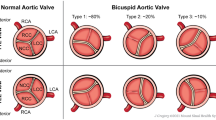Abstract
While quadricuspid morphology is commonly observed in truncal valves, quadricuspid aortic valves (QAV) are rare and their natural history is not well described. This retrospective study of 37 patients describes the diagnostic associations and morphologic variability of QAVs in children (median age at diagnosis 4.3 y IQR 0–12 y). Associated congenital heart diseases were present in 54% (most commonly tetralogy of Fallot (TOF) and valvar pulmonary stenosis). Among patients with isolated QAV, 11 had genetic syndrome and 5 had skeletal anomalies. Valve morphology was most commonly type B (41%) and A (35%; Hurvitz and Roberts). Dilated aortic root (Z ≥ 2) was present in 5 and dilated ascending aorta in 9 patients at diagnosis. All patients with type C (n = 3) and G (n = 1) had aortic dilation. At diagnosis, >mild AR was rare (n = 1), mild regurgitation was common (n = 12, 32%), >mild AS was rare (n = 2), and mild AS was uncommon (n = 4). Over a median follow-up of 3.3y (IQR 0.9-11y), progression of AR was seen in 2 patients and progression of aortic root or ascending aorta dilation (increase in Z score by ≥ 2) was seen in 5 patients. In conclusion, QAV is a rare congenital anomaly and about half of the cases are found in hearts that are otherwise structurally normal. A relatively high prevalence is seen in patients with TOF, pulmonary stenosis, skeletal deformities, and genetic syndromes. Meticulous evaluation of aortic valve morphology should be conducted on echocardiograms performed for these indications.

Similar content being viewed by others
Data Availability
No datasets were generated or analysed during the current study.
References
Feldman BJ, Khandheria BK, Warnes CA et al (1990) Incidence, description and functional quadricuspid aortic valves Assessment of isolated. Am J Cardiol 65:937–938
Hurwitz LE, Roberts WC (1973) Quadricuspid semilunar valve. Am J Cardiol 31:623–626. https://doi.org/10.1016/0002-9149(73)90332-9
Di Pino A, Gitto P, Silvia A, Bianca I (2008) Congenital quadricuspid aortic valve in children. Cardiol Young 18:324–327. https://doi.org/10.1017/S1047951108002205
Brock M (2013) Case report. https://doi.org/10.4103/0974-2069.115285. Ann Pediatr Cardiol 6:
Brugts JJ, Cuypers JAAE, Polak P et al (2015) Quadricuspid aortic valve and anomalous systemic venous connection in a patient with cat-eye syndrome. Circulation 131:1225–1227. https://doi.org/10.1161/CIRCULATIONAHA.114.013290
Hebeler KR, Squiers JJ, Baumgarten H et al (2016) David-V Procedure in a patient with aortic dilation and competent quadricuspid aortic valve: are Genetics to blame? Aorta Stamford Conn 4:178–180. https://doi.org/10.12945/j.aorta.2016.16.033
Malakan Rad E, Pouraliakbar H (2017) Congenital unruptured aneurysm of sinus of Valsalva, quadricuspid aortic valve, and ascending aortic aneurysm associated with genetic leukoencephalopathy in an infant: a new syndrome? Echocardiogr Mt Kisco N 34:1959–1964. https://doi.org/10.1111/echo.13723
Kantaputra P, Buaban K, TN et al (2023) Broad spectrum of anomalies including quadricuspid aortic valve associated with a novel frameshift SALL4 variant. Clin Genet 104:133–135
Gouveia S, Ferreira Martins JD, Costa G et al (2011) Quadricuspid aortic valve – 10-year case series and literature review. Rev Port Cardiol Engl Ed 30:849–854. https://doi.org/10.1016/J.REPCE.2011.10.003
Robicsek F, Sanger PW, Daugherty HK, Montgomery CC (1969) Congenital quadricuspid aortic valve with displacement of the left coronary orifrice. Am J Cardiol 23:288–290. https://doi.org/10.1016/0002-9149(69)90080-0
Tsang MYC, Abudiab MM, Ammash NM et al (2016) Quadricuspid aortic valve: characteristics, Associated Structural Cardiovascular Abnormalities, and clinical outcomes. Circulation 133:312–319. https://doi.org/10.1161/CIRCULATIONAHA.115.017743
Colan SD (2016) Normal echocardiographic values for Cardiovascular structures. In: Lai WM, Mertens LL, Cohen MS, Geva T (eds) Echocardiography in Pediatric and congenital heart Disease from Fetus to Adult, Second. Wiley-Blackwell
Kramer TC (1942) The partitioning of the truncus and conus and the formation of the membranous portion of the interventricular septum in the human heart. Am J Anat 71:343–370. https://doi.org/10.1002/aja.1000710303
Gellis L, Binney G, Alshawabkeh L et al (2020) Long-term fate of the Truncal Valve. J Am Heart Assoc 9:e019104. https://doi.org/10.1161/JAHA.120.019104
Chen T, Guestrin C (2016) XGBoost: A Scalable Tree Boosting System. In: Proceedings of the 22nd ACM SIGKDD International Conference on Knowledge Discovery and Data Mining. ACM, San Francisco California USA, pp 785–794
Bravo-Jaimes K, Prakash SK (2020) Genetics in bicuspid aortic valve disease: where are we? Prog Cardiovasc Dis 63:398–406. https://doi.org/10.1016/j.pcad.2020.06.005
Brock M, Tugertimur A, Schwartz MC (2013) IMAGES a rare pediatric cardiac anomaly: quadricuspid aortic valve with aortic regurgitation. 6:202–203. https://doi.org/10.4103/0974-2069.115285
Rodríguez-Palomares JF, Dux-Santoy L, Guala A et al (2023) Mechanisms of aortic dilation in patients with bicuspid aortic valve: JACC state-of-the-art review. J Am Coll Cardiol 82:448–464. https://doi.org/10.1016/j.jacc.2022.10.042
Martin PS, Kloesel B, Norris RA et al (2015) Embryonic Development of the bicuspid aortic valve. J Cardiovasc Dev Dis 248–272. https://doi.org/10.3390/jcdd2040248
Klassen SL, Hutchison SJ (2019) Quadricuspid aortic valvulopathy and Acute Type A aortic dissection. AORTA J 7:93. https://doi.org/10.1055/S-0039-1692457
Funding
The project was completed with no external funding support.
Author information
Authors and Affiliations
Contributions
Conceptualization, methodology and data curation: OA, FA, SG. Formal analysis and investigation: OA, FA, SG. Writing – original draft: OA. Writing – review & editing: FA, SS, KB, RB, SG. Resources, project administration, supervision, validation, and visualization: SG.
Corresponding author
Ethics declarations
Competing Interests
The authors have no financial relationships relevant to this article to disclose.
Additional information
Publisher’s Note
Springer Nature remains neutral with regard to jurisdictional claims in published maps and institutional affiliations.
Rights and permissions
Springer Nature or its licensor (e.g. a society or other partner) holds exclusive rights to this article under a publishing agreement with the author(s) or other rightsholder(s); author self-archiving of the accepted manuscript version of this article is solely governed by the terms of such publishing agreement and applicable law.
About this article
Cite this article
Ajayi, O., Alizadeh, F., Sekhavat, S. et al. Morphology, Clinical Associations, and Pathologic Follow-up of Quadricuspid Aortic Valves in Children. Pediatr Cardiol (2024). https://doi.org/10.1007/s00246-024-03471-3
Received:
Accepted:
Published:
DOI: https://doi.org/10.1007/s00246-024-03471-3




